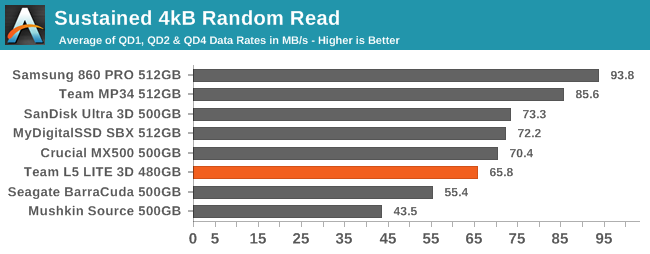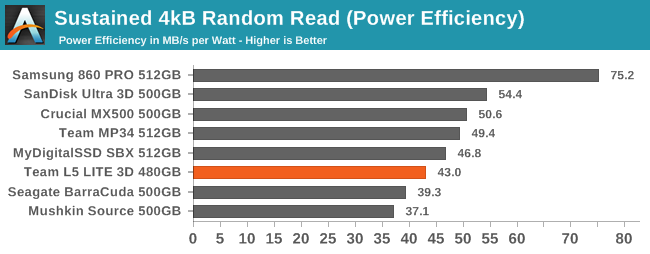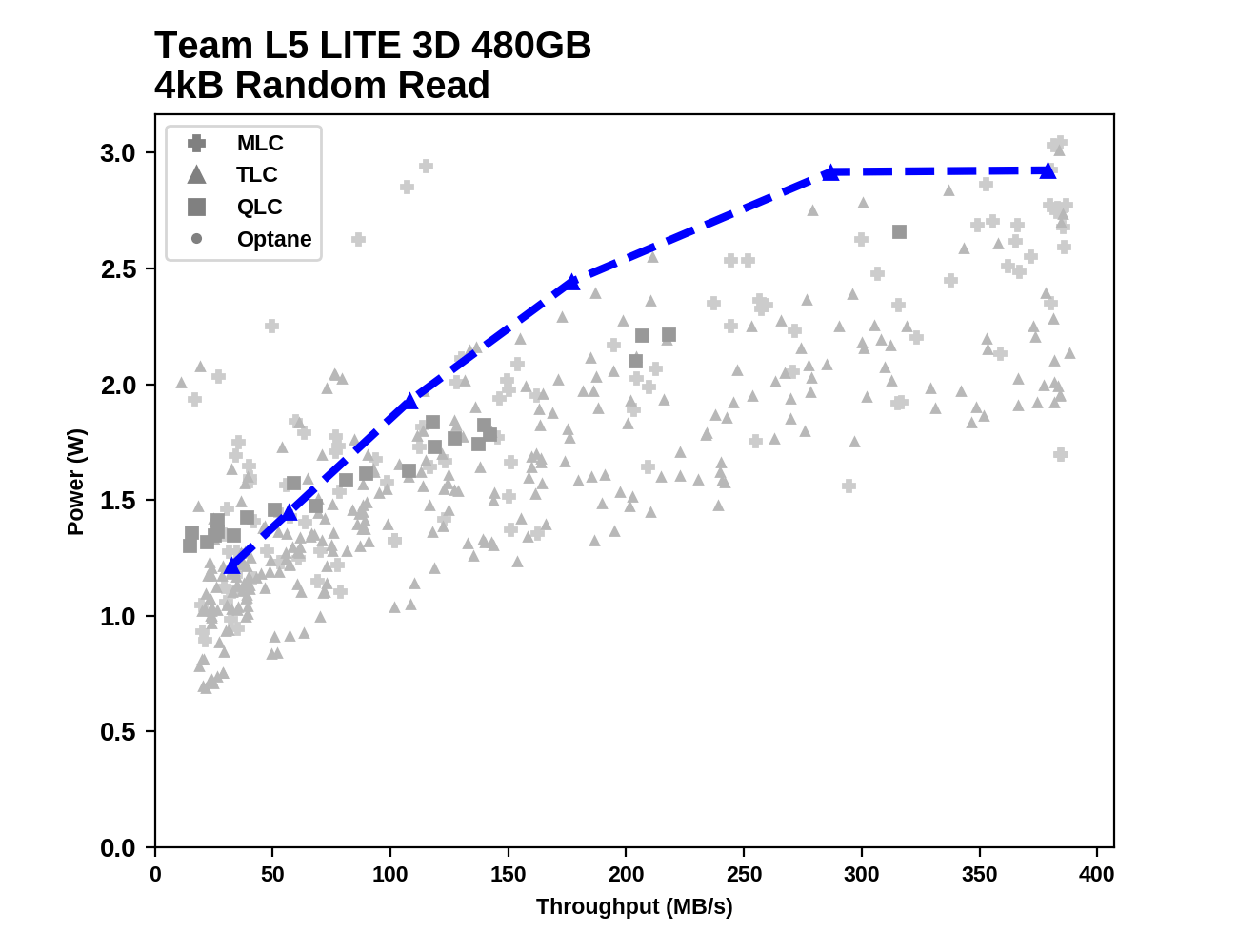The TeamGroup L5 LITE 3D (480GB) SATA SSD Review: Entry-Level Price With Mainstream Performance
by Billy Tallis on September 20, 2019 9:00 AM EST- Posted in
- SSDs
- SATA
- Silicon Motion
- SM2258
- TeamGroup
Burst IO Performance
Our burst IO tests run at a queue depth of one and the amount of data transferred is limited to ensure that SLC write buffers don't fill up and controllers don't overheat. In between each burst there's enough idle time to keep the drive averaging a 20% duty cycle, allowing for some buffered writes and deferred garbage collection to be completed. The random read and write tests use 4kB operations and the sequential tests use 128kB operations. All the burst tests are confined to a 16GB portion of the drive, so DRAMless SSDs are not disadvantaged as much as they are for larger tests.
 |
|||||||||
| Random Read | Random Write | ||||||||
| Sequential Read | Sequential Write | ||||||||
The SATA SSDs in this bunch all perform very similarly on the burst sequential IO tests, though the TeamGroup L5 LITE 3D is hair slower than the rest for sequential writes. The random write performance is tied for first place among the SATA drives, but the random read performance is much slower than the Crucial MX500.
Sustained IO Performance
Our sustained IO tests measure performance on queue depths up to 32, but the scores reported here are only the averages for the low queue depths (1,2,4) that are most representative of real-world consumer workloads. Each queue depth is tested for up to one minute or 32GB, and the tests are confined to a 64GB span of the drive.
 |
|||||||||
| Random Read | Random Write | ||||||||
| Sequential Read | Sequential Write | ||||||||
The Team L5 LITE 3D's sustained sequential performance isn't quite the fastest among the SATA SSDs, but it does stand out for having pretty good performance when performing sequential reads on data that was written with random writes. The random write performance of the L5 LITE 3D is as good as any of the TLC SATA drives in this batch, but the random read performance is a bit slower than the top tier SATA drives.
 |
|||||||||
| Random Read | Random Write | ||||||||
| Sequential Read | Sequential Write | ||||||||
The L5 LITE 3D's power efficiency during the random write test is pretty good by TLC SATA standards, but otherwise it tends to fall short by a bit. The Mushkin Source DRAMless SATA drive turns in some great efficiency scores thanks to really low power draw (helped by the lack of DRAM), but DRAMless performance on random reads is far too low for it to remain competitive on that efficiency metric.
 |
|||||||||
| Random Read | Random Write | ||||||||
| Sequential Read | Sequential Write | ||||||||
Plotting the L5 LITE 3D's performance and power at various queue depths against all the other SATA drives in our database shows that the random read power consumption starts to look excessive at medium to high queue depths. For the other workloads, the L5 LITE 3D is at least nowhere near setting a record for good power efficiency, but it does sometimes manage to be better than average.
At high queue depths, the L5 LITE 3D reaches the same SATA throughput limits as everything else for read operations, but the the write speeds top out a bit below the practical maximum for the best SATA SSDs.
 |
|||||||||
| Random Read | |||||||||
| Random Write | |||||||||
| Sequential Read | |||||||||
| Sequential Write | |||||||||
Putting the L5 LITE 3D head to head against other TLC SATA drives makes it clear that the Team drive can almost always hold its own on the performance front. The power consumption is where it loses, and sometimes by a pretty wide margin: the Mushkin Source is a full 1W ahead of the L5 LITE 3D for sequential writes, and the Crucial MX500 is ahead by about 0.5W for random reads at high queue depths.










42 Comments
View All Comments
flyingpants265 - Friday, September 20, 2019 - link
Why promote this drive without mentioning anything about the failure rates? Some Team Group SSDs have 27% 1-star reviews on newegg. That's MUCH higher than other manufacturers.. That's not worth saving $5 at all... Is Anandtech really that tone-deaf now?-I would not recommend this drive to others -- 5 months, dead.
-Not safe for keep your data.Highly recommend not to store any important data on it
-DO NOT BUY THIS SSD! Total lack of support for defective products! Took days to reply after TWO requests for support, and then I am expected to pay to ship their defective product back when it never worked!?
-Failed and lost all data after just 6 months.
...
Ryan Smith - Friday, September 20, 2019 - link
"Is Anandtech really that tone-deaf now?"Definitely not. However there's not much we can say on the subject with any degree of authority. Obviously our test drive hasn't failed, and the drive has survived The Destroyer (which tends to kill obviously faulty drives very early). But that's the limit to what we have data for.
Otherwise, customer reviews are a bit tricky. They're a biased sample, as very happy and very unhappy people tend to self-report the most. Which doesn't mean what you state is untrue, but it's not something we can corroborate.
* We've killed a number of SSDs over the years. I don't immediately recall any of them being Team Group
eastcoast_pete - Friday, September 20, 2019 - link
Ryan, I appreciate your response. Question: which SSDs have given up the ghost when challenged by the "destroyer"? Any chance you can name names? Might be interesting for some of us, even in historic context. Thanks!keyserr - Friday, September 20, 2019 - link
Yes anecdotes are interesting. In an ideal world we would have 1000 drives of each model put through its paces. We don't.It's a lesser known brand. It wouldn't make too much sense if they made bad drives in the long term.
Billy Tallis - Friday, September 20, 2019 - link
I don't usually keep track of which test a drive was running when it failed. The Destroyer is by far the longest test in our suite so it catches the blame for a lot of the failures, but sometimes a drive checks out when it's secure erased or even when it's hot-swapped.Which brands have experienced a SSD failure during testing is more determined by how many of their drives I test than by their failure rate. All the major brands have contributed to my SSD graveyard at some point: Crucial, Samsung, Intel, Toshiba, SanDisk.
eastcoast_pete - Friday, September 20, 2019 - link
Billy, I appreciate the reply, but would really like to encourage you and your fellow reviewers to "name names". An SSD going kaplonk when stressed is exactly the kind of information that I really want to know. I know that such an occurrence might not be typical for that model, but if the review unit provided by a manufacturer gives out during testing, it doesn't bode well for regular buyers like me.Death666Angel - Friday, September 20, 2019 - link
You can read every article, I remember a lot of them discussing the death of a sample (Samsung comes to mind). But it really isn't indicative of anything: sample size is crap, early production samples (hardware), early production samples (software). Most SSDs come with 3 years of warranty. Just buy from a reputable retailer, have a brand that actually honors warranty and make sure to back up your data. Then you're fine. If you don't follow those those rules, even using the very limited data Billy could give you won't help you out in any way.eastcoast_pete - Friday, September 20, 2019 - link
To add: I don't just mean the manufacturers' names, but especially the exact model name, revision and capacity tested. Clearly, a major manufacturer like Samsung or Crucial has a higher likelihood of the occasional bad apple, just due to the sheer number of drives they make. But, even the best big player produces the occasional stinker, and I'd like to know which one it is, so I can avoid it.Kristian Vättö - Saturday, September 21, 2019 - link
One test sample isn't sufficient to conclude that a certain model is doomed.bananaforscale - Saturday, September 21, 2019 - link
This. One data point isn't a trend. Hell, several data points aren't a trend if they aren't representative of the whole *and you don't know if they are*.